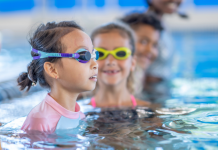“Mama’s Don’t Let Your Babies Grow Up To Be Athletes”…What???
 Can anyone hear Willie Nelson singing this version of his hit song and imagine if it was a hit song today? No way! Our culture is all about getting kids physically active in organized activities, particularly at younger ages.
Can anyone hear Willie Nelson singing this version of his hit song and imagine if it was a hit song today? No way! Our culture is all about getting kids physically active in organized activities, particularly at younger ages.
As mothers we do our best from the very beginning to protect our children. We eat right, take care of our bodies, and get check-ups to ensure to the best of our abilities – the protection of our children in the womb. Once they are here, we hold their hand, walk closely behind them, feed them right, and watch what they are exposed to in order to protect them. Once they reach a certain age, we realize they are going to engage in activities or attempt physical feats that make us as mothers grimace and wince with the hope of no traumatic injuries or trips to the ER.
Athletics. Most of us love them and enjoy them personally but when our children become the participants, we as mothers love to see our children succeed but not at the cost of physical pain and injury. According to an article in the November, 2009 Journal of Athletic Training; “An estimated 12 million athletes between the ages of 5 and 22 suffered sports-related injuries annually leading to 20 million lost days of school and approximately $33 billion spent in health care costs in the U.S. alone.”1
There are simple steps we can take as parents to help our children succeed in athletics, as well as prevent injuries. As a mother of three who are more active in athletics yearly, and a physical therapist that sees the results of injuries, I can attest to these steps in preventing simple injuries.
Many injuries young athletes incur are preventable. Simple steps such as proper hydration, adequate warm-up and cool down, and proper use of safety equipment can make a significant decrease in the occurrence of injuries:
Hydration:
- It seems simple, but hydration can become more complicated based on your child’s activity level and the temperature at which they are performing activities in. Encourage children to drink before, during, and after sports. According to www.momsteam.com here are some recommended guidelines.
|
Ages 6 to 12: |
Ages 13 to 18: |
|
Before SportsDrinking fluids prior to exercise appears to reduce or delay the detrimental effects of dehydration.
|
Before SportsDrinking fluids prior to exercise appears to reduce or delay the detrimental effects of dehydration.
|
|
During Sports
|
During Sports
|
|
After Sports
|
After Sports
|
- This website http://www.bottledwater.org/public/hydcal/input1.html is a helpful tool to calculate proper hydration amounts for people 100 lbs. and over.
- Sports drinks-There is some controversy of whether sports drinks are beneficial to young athletes and the level of performance they participate at. Sports drinks, which are usually sugar filled, are not necessary for young athletes unless they are participating in extremely vigorous activity.2 According to the National Federation of State High School Association, water is the best resource for hydration but there are some situations according to National Athletic Trainers’ Association (NATA) that sports drinks with appropriate carbohydrate and sodium balance are beneficial for fluid replacement.4, 5
- One way to encourage proper hydration is to ensure your child has a refillable water bottle on the sidelines during athletic participation and encourage them to drink frequently.
Warm-up/Cool-down:
Another easy injury prevention strategy is to have your child warm-up and cool-down appropriately. Doing so can prevent muscle strains. Most kids, as well as my own; jump in the car, head to the game, get on the court or field with a brief warm up before the game. After the game ends it is straight to the drinks and snacks and there is no cool down involved. There is minimal stretching and dynamic flexibility encouraged in young athletes due to lack of time and awareness of the benefits of brief warm up activities.
- Warm-up: As parents, we can be part of the solution by having your child do some light stretching at home before you head to the game and throughout the week. You can encourage dynamic flexibility for a more focused warm-up with a couple of slow jogs up and down the drive. You can also encourage some warm-up sport specific drills at home or arrive 5-10 minutes early to perform them at the game or competition.
- Cool-down: Encourage your child to do some light stretching following activity participation in order to prevent increased muscle tightness and soreness. It also helps decrease body temperature and decreases heart rate slowly following intense activities.
- If you are unsure of where to start with a good program contact a physical therapist, physician, CSCS, or an athletic trainer.
Safety equipment:
Equipment is a key factor in preventing sports related injuries in youth.
- Concussions: On a more serious note that is gaining awareness, concussions are one of the top injuries in sports that require medical attention. As all coaches are being required to take training on concussion awareness. I believe it is just as important for parents to be aware of what to look for regarding concussions when their children are playing more contact sports.
According to the CDC; bicycling, football, playground activities, basketball and soccer were associated with the highest number of traumatic brain injuries (TBI).6 You can learn more about concussions, prevention, and what to look for at http://www.cdc.gov/concussion/sports/index.html. If you are in doubt if the injury is serious, seek medical attention.
- Proper footwear that is appropriate for field play, mouth guards, helmets and adult supervision are all important factors for preventing injuries with sport participation.
Now we know we can’t wrap our kids up in bubble wrap and send them out to play. Since you can’t protect them from everything you now have some resources and tools you can use to help prevent the “preventable” injuries. It is healthy to encourage kids to be physically active, although injury is a risk we take.
Sports participation has many beneficial effects such as decreased obesity rate, improved cardiac and overall physical health, improved psychological and emotional health, improved academic performance, and increased self-confidence.7 So, send your kids out to play the sports they will be passionate about and enjoy watching them succeed.
Sources:
- Valovich McLeod TC, Bay RC, Parsons JT, Sauers EL, Synder AL. Recent Injury and Health-Related Quality of Life in Adolescent Athletes. Journal of Athletic Training. 44(6):603–610, 2009.
- Children’s Hospital Boston. Division of Sports Medicine. The Sports Medicine Bible for Young Athletes (SourceBooks, 2002) by Dr. Lyle Micheli http://www.childrenshospital.org/clinicalservices/Site1172/Documents/nutrition%20and%20hydration%20042507.pdf
- De Lench, Brooke. Youth Sports Hydration Guidelines-Drink on Schedule, Not Just When Thirsty. http://www.momsteam.com/nutrition/sports-hydration/fluid-guidelines/fluid-guidelines-for-young-athletes#ixzz2OVlAPIwn.
- Casa DJ, Armstrong LE, Hillman SK, Montain SJ, Reiff RV, Rich BSE, Roberts WO, Stone JA. National Athletic Trainers’ Association Position Statement: Fluid Replacement for Athletes. Journal of Athletic Training. 35(2):212-224, 2000.
- National Federation of State High School Associations. What to Drink for Sports, What Not to Drink. Hydrate Before Sports, Re-Hydrate During and After Sports. http://www.momsteam.com/health-safety/what-to-drink-for-sports-what-not-to-drink-for-sports?page=0%2C1#ixzz2OVqrzOKX.
- Centers for Disease Control and Prevention. Injury Prevention and Control: Traumatic Brain Injury. Concussion in Sports. www.cdc.gov/concussion/sports/index.html
- True Sport. Psychological and Social Benefits of Playing True Sport. http://www.truesport.org/about/true-sport-report/psychological-and-social-benefits-of-playing-true-sport
Guest Blogger Amy Entrekin
 Amy Entrekin is an Iowa native farm-girl that has moved to the suburbs. She graduated from Midwestern State University in Wichita Falls, TX where she met her husband Aaron. She won over the Texas man who moved to Iowa and they now live in Ankeny, IA with their three children Eric (December 2004), Ava (February 2007), and Evan (November 2008).
Amy Entrekin is an Iowa native farm-girl that has moved to the suburbs. She graduated from Midwestern State University in Wichita Falls, TX where she met her husband Aaron. She won over the Texas man who moved to Iowa and they now live in Ankeny, IA with their three children Eric (December 2004), Ava (February 2007), and Evan (November 2008).
Amy is a physical therapist at Johnston Physical Therapy and Sports Medicine. She is passionate about helping people regain an active lifestyle after an injury as well as educating them on prevention and general wellness.
She has been blessed with the opportunity to work in a field she is passionate about on a part-time basis while spending time being a full-time mom. She enjoys serving others and being involved in their church (First Family Church). You never know who God has placed in your path today to serve, so let’s get ready and get our hands dirty.
















